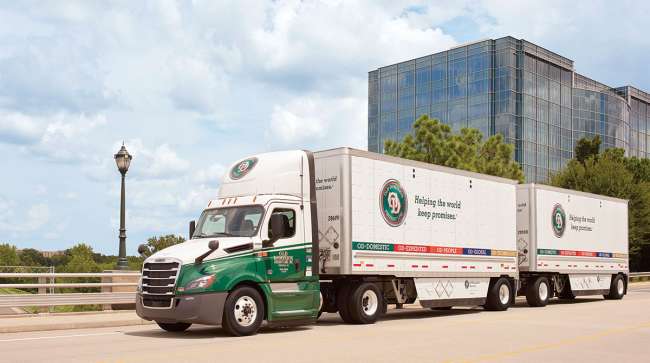Staff Reporter
Old Dominion Sees First Year-Over-Year Revenue Drop in 2024

[Stay on top of transportation news: Get TTNews in your inbox.]
Old Dominion Freight Line experienced a slight decline in third-quarter revenue amid ongoing market softness, the company reported Oct. 23.
The Thomasville, N.C.-based less-than-truckload carrier posted net income of $308.6 million, or $1.43 a diluted share, for the three months ending Sept. 30. That compared with $339.2 million, $1.54, during the year-ago period. Total revenue decreased 3% to $1.47 billion from $1.52 billion.
Old Dominion Freight Line ranks No. 8 on the Transport Topics Top 100 list of the largest for-hire carriers in North America and No. 2 on the LTL list.
“Old Dominion’s financial results in the third quarter reflect continued softness in the domestic economy,” CEO Marty Freeman said during a conference call with investors. “Our revenue and earnings per diluted share both declined on a year-over-year basis during the quarter, although our market share and volume trends remained relatively consistent with the first half of the year.”
Freeman noted that there have been efforts to manage variable costs and control discretionary spending. But he also revealed that the deleveraging effect from the decrease in revenue caused many of the company's cost categories to increase as a percentage of revenue. This was the primary driver for the increase in the company operating ratio to 72.7.
“We have been pleased with the consistency in our market share this year, which is consistent with our historical experience during slower parts of the economic cycle,” Freeman said. “We continue to have strong customer retention trends, and we are also winning new business. Our customers simply have had fewer shipments that they contender to us and our average weight per shipment has also remained at historical lows.
Freeman noted that the focus is on maintaining a long-term and disciplined approach to pricing. That has involved consistently improving yields to sufficiently offset cost inflation and support additional investments in capacity and technology. He noted that these ongoing investments then create incremental value for customers.
McLeod Software CEO Tom McLeod explores the potential for artificial intelligence to boost efficiency and build resilience. Tune in above or by going to RoadSigns.ttnews.com.
“Our customers have recognized our value proposition over time, which has allowed us to be able to earn more and more of their business,” Freeman said. “As a result, we have won more market share over the past 10 years than any carrier in our industry. While the economic environment has remained sluggish for much longer than we ever anticipated, we believe we are better positioned than ever to respond to the eventual inflection in demand.”
ODFL said that its main less-than-truckload services experienced revenue decline of 2.9% to $1.46 billion from $1.5 billion. The drop-off in revenue primarily was due to a 4.8% decrease in LTL tons per day that was partially offset by a 1.5% increase in LTL revenue per hundredweight. ODFL also had an additional operating day compared with the third quarter of 2023.
“The decrease in LTL tons per day reflects a 3.4% decrease in LTL shipments per day and a 1.4% decrease in LTL weight per shipment,” Freeman said. “LTL revenue per hundredweight, excluding fuel surcharges, increased 4.6% as compared to the third quarter of 2023, as we maintained our long-term and disciplined approach to pricing.
“We continue to focus on consistently improving our yields to offset our cost inflation and support our ongoing investments in capacity, technology and our OD family of employees.”
Want more news? Listen to today's daily briefing above or go here for more info
ODFL has maintained relatively consistent market share and volume this year. Freeman added that yields also have continued to improve. He noted that these results are being supported by 99% on-time service and a cargo claims ratio of 0.1 during Q3.
“Our operating ratio increased by 210 basis points to 72.7% for the third quarter of 2024,” Freeman said. “The decrease in revenue had a deleveraging effect on many of our operating expenses, which contributed to the 110-basis-point increase in our overhead costs as a percent of revenue.”
The results matched Wall Street’s expectations. Analysts had been looking for $1.43 per share and quarterly revenue of $1.52 billion, according to Zacks Consensus Estimate. Susquehanna International Group noted in a report that the results aligned with its expectations with its tepid volume but steady yields. The investment company pointed out that pricing discipline continues to hold despite underlying volume being in a sustained downturn.
“In the near term, soft industrial indicators, typically muted 4Q LTL seasonality. and real-time transport data [and] checks suggest little hope for recovery into early 2025,” SIG analyst Bascome Majors wrote in the report. “That said, we see a credible case for gradual volume recovery next year, with inflation cooling, the Fed starting its easing cycle, a deep 2.5-year freight recession already long by historical standards and very early signs of price stability in the much larger truckload market.”





